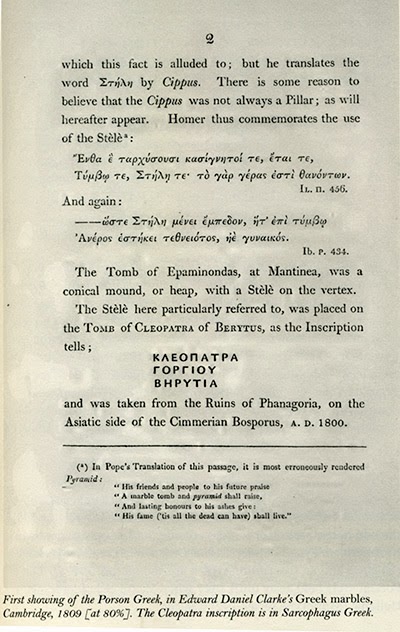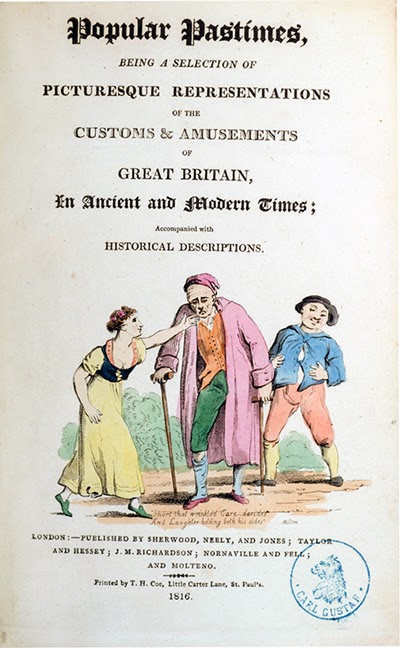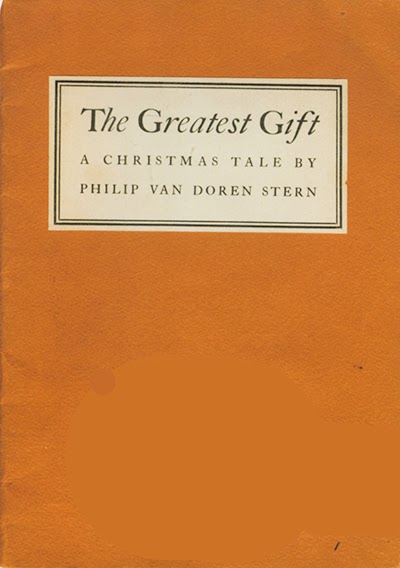by Stephen J. Gertz![]() |
Title-page.
"Short that wrinkled Care derides
And Laughter holding both his sides." |
In Margochanningescu, a Romanian hamlet associated with Vlad the Impaler, villagers fasten their seat belts when a full moon portends a bumpy night with vicious conversation that drains the blood from unsophisticated brains.
In Bad Temper, a burg so isolated within Germany's Black Forest that residents have evolved into a new species of hominid, ancient tradition demands that maidens who have reached their first menses must perform the Schuhplattler courtship dance in the town square balanced upon only one of their three legs and blow a gasket when males who have reached puberty tickle each other instead of the girls' fancy axillary regions.
On the corner of Pico & Barrington in West Los Angeles, California, where discount mattress stores dominate an otherwise barren retail landscape, Campfire Girls are encouraged by tribal elders to earn their merit badges in Billing & Cooing by performing The Slapstick Serenade, to wit: whistling to male passersby The Flight of the Bumble Bee while lying supine upon a tattered boxspring abandoned in an alley, wiggling their eyebrows as a leering Groucho Marx, and afterward reciting the Campfire Girls Oath in Esperanto with Yiddish accent while tying two unmatched socks found lying in a gutter into a knot worthy of King Gordius of Phrygia. They then bake a meringue pie and throw it into the face of the one whose heart they seek to win and later, after their inauspicious first driving lesson with swain as instructor, roughly dice their true love's ticker into 1" squares then toss into a food processor and puree.
The above rituals, collected by Sir Woodrow Knotty Pine-Coffin in
Dubious Rites of Apocryphal Peoples from Around the World, are run-of-the-mill compared to those found in
Popular Pastimes, being a Selection of Picturesque Representations of the Customs & Amusements of Great Britain in Ancient and Modern Times, an anonymously written book published in 1816 with hand-colored plates after designs by
Francis Philip Stephanoff (1788-1860) illustrating twenty of the book's thirty chapters.
Popular pastimes covered in the book include foot-ball, exorcism, chasing and kissing under the mistletoe, claiming a flitch of bacon after a year of conjugal happiness and lack of strife, wife-selling, whipping the cock, donkey riding, bull-baiting, the fool plough and sword dance, the smock race, swearing in the Sheriffs, the milk-maid's garland (not to be confused with the Punch & Judy garland), and etc.
![]() |
| Selling A Wife. |
"Among the customs unknown to the law in this country,, though by the illiterate and vulgar supposed to be of legal validity and assurance, is that of SELLING A WIFE, like a brute animal, in a common market-place. At what period this practice had origin we have not discovered, but it has unquestionably been in existence for a long series of years; and many instances might be given of the extensive spread of this licentious custom in more modern times…"
For example, "on the 11th of March 1803… 'a private individual led his Wife to Sheffield market, by a cord tied round her waist, and publicly announced that he wanted to sell his cow. On this occasion, a butcher who officiated as auctioneer, and knocked down the lot for a guinea, declared that he had not brought a cow to a better market for many years.' …On the 27th of March, 1808… 'a man publicly sold his Wife to a fisherman, in the market at Brighton, for twenty shillings and a blunderbuss.'
"This practice, immoral and shameful as it is, has given to various pleasant Jeu d'esprits…"
![]() |
| Heaving. |
"In the mode of Heaving, there is considerable variation in different districts; but it is general, we believe, for the men to lift the women on Easter Monday, and the women the men, on Tuesday. In Manchester, Bolton, and other towns in Lancashire, parties are formed, who surround every one of the opposite sex that they meet, and either with or without their consent, take hold of their legs and arms, and lift them thrice above their heads, into the air, in a horizontal position, with loud shouts at each elevation. a small sum must be paid for ransom by the persons thus elevated.
"At Manchester, the magistrates constantly prohibit this indecent practice, yet it is still carried on in the outskirts of the town. In Cheshire, Shropshire, &c. the men go with a chair into every house to which they can obtain admission, and forcing every female to be seated in their vehicle, lift them up three times with loud huzzas. For this they claim a kiss, which, however, is remitted to the coy on payment of a fine. On the following day the women have the same privilege, and pursue it with equal license. In North Wales the Heavers travel from house to house, both in town and country, and have frequently a fiddle playing before them."
![]() |
| Riding The Stang. |
"The vulgar of every country have particular customs, which, being immediately subversive of decorum and good order, can only be practiced at uncertain intervals, when magistracy sleeps, or a more than common effervescence of popular daring condemns authority, and overbears control: of this description is the ignominious punishment called RIDING THE STANG….
"'Riding the Stang,' according to Dr.. Jamieson, 'is the remains of a very ancient cuetom among the Goths, who were wont to erect what they called Nidstaeng, on the pole of infamy, with the most dire imprecations against those who were thought to deserve the reprobation which this act implied. The person thus subjected to dishonor was called Niding, or infamous, and he was thenceforth deemed incapable of making oath in any cause.'
"Callender observes, that in Scotland, 'Riding the Stang is a mark of the highest infamy, and the person who has been thus treated seldom recovers his honor in the opinion of his neighbors.'
"'I am informed,' says Dr. Jamieson, 'that in Lothian, and, perhaps, in other countries, the man who had debauched his neighbor's wife was formerly forced to ride the Stang,' yet this punishment was not exclusively inflicted on gallants detected in criminal amours. The virago who had beaten her husband was also subjected to ride the Stang…"
![]() |
| Skimmington, or the Shrew. |
"Skimmington, or 'Riding Skimmington,' is a custom very analogous to that of Riding the Stang; it seems, principally, to have been inflicted by the populace on lewd and scolding women, but sometimes, also, on those willing cornutoes who basely contented themselves with deriving profit from their wives' prostitution. The derivation of the term has not been traced: Mr. Douce deduces it from the skimming-ladle, with with the shameless termagant, in these processions, was permitted to chastise her husband; but Mr. Brand, with more likelihood, from the name of some errant scold, whose celebrity was sufficiently notorious to place her at the head of the profession, and thence by an easy metonymy, to occasion the appellation of a 'Skimmington' to be given to every proficient in her line.
"In the 'Gentleman's Dictionary,' a Skimmington is defined to be 'a sort of burlesque procession in ridicule of a man who suffers himself to be beat by his wife;' and Grose, in his Provincial Glossary, after a similar definition, gives the ensuing particulars of the cavalcade: 'It consists of a man riding behind a woman with his face to the horse's tail, holding a distaff in his hand, at which he seems to work, the woman all the while beating him with the ladle; a smock displayed upon a staff is carried before them, as an emblematical standard, denoting female superiority…'
"...Colmelar, in his 'Delices de l'Espagne,' &c. speaking of Spanish manners, states, that, 'When a man, for the sake of profit, knowingly suffers his wife to cuckold him, they are, on discovery, both seized, set astride upon an ass, and publicly exposed; the cornato having on a very large pair of horns, hung with small bells, and the wife being compelled to flog him, whilst she, herself, is lashed by the executioner.'"
![]() |
| The Mistletoe. |
"As the ivy is dedicated to Bacchus, so should the Mistletoe be to Love; not, however, to the chaste Eros, but to the sportive Cupid. The sacred regard given to it in pagan and Druidical rites has long been terminated; but it is still beheld with emotions of pleasurable interest, when hung up in our kitchens at Christmas; it gives license to seize 'the soft kiss' from the ruby lips of whatever female can be enticed or caught beneath. So custom authorizes, and it enjoins also, that one of the berries of the Mistletoe be plucked off after every salute. Though coy in appearance, the 'chariest maid' at this season of festivity is seldom loth to submit to the established usage; especially when the swain who tempts her is one whom she approves.
![]() |
| Whipping The Cock. |
Whipping The Cock has nothing to do with that other popular, though usually private, pastime, Slapping The Monkey, and shame on you for thinking otherwise.
"'Whipping The Cock,' according to Grose, 'is a piece of sport practiced at wakes, horse races, and fairs, in Leicestershire: a Cock being tied or fastened into a hat or basket, half a dozen carters, blindfolded, and armed with their cart whips, are placed round it, who, after being turned three thrice about, begin to whip the cock, which if any one strikes so as to make it cry out, it becomes his property; the joke is, that instead of whipping the Cock they flog each other heartily.'"
Popular Pastimes, alas, does not include a color-plate to illustrate its chapter on Sowing Hemp-Seed. All we can provide are excerpts from the text.
"Among the Love divinations still in vogue with our peasant girls is that of SOWING HEMP SEED on Midsummer Eve, for the purpose of discovering who their true sweethearts are. This custom is thus pleasingly noticed in the 'Connoisseur' at the same season by our country lasses. 'I and my two sisters tried the dumb cake together; you must know, two must make it, two bake, two break it, and the third put it under each of their pillows (but you must not speak a word all the time), and then you will dream of the man you are to have. This we did: and to be sure I did nothing all night but dream of Mr. Blossom.
"'The same night, exactly at twelve o'clock, I sowed Hemp-seed in our back yard, and said to myself these words,
Hemp-seed I sow, Hemp-seed I hoe,
And he that is my true love,
Come after me and mow. -
"'Will you believe me? I looked back and saw him behind me, as plain as eyes could see him.'"
We can only presume that the lasses were smoking as well as sowing hemp-seed. Or, perhaps, Banging The Gong, a popular pastime among devotees of the poppy in Devonshire.
__________
[STEPHANOFF, F.P., illustrator].Popular Pastimes, Being a Selection of the Customs & Amusements of Great Britain, In Ancient and Modern Times; Accompanied by Historical Descriptions. London: Published by Sherwood, Neely, and Jones; Taylor and Hessy; J.M. Richardson; Nornaville and Fell and Molteno, 1816.
First edition, earliest issue, with plates watermarked 1814. Octavo (8 3/16 x 5 in; 208 x 129 mm). [2], 126, iv [i.e. 2 as Contents, misbound] pp. Hand-colored title vignette and twenty hand-colored plates after F.P. Stephanoff with tissue guards.
Notes and Queries, January 21, 1905, p. 60. Book Prices Current, 1895, no. 155.
__________
Images courtesy of
David Brass Rare Books, with our thanks.
__________
__________
![]()
![]()
_13.jpg)
































































































